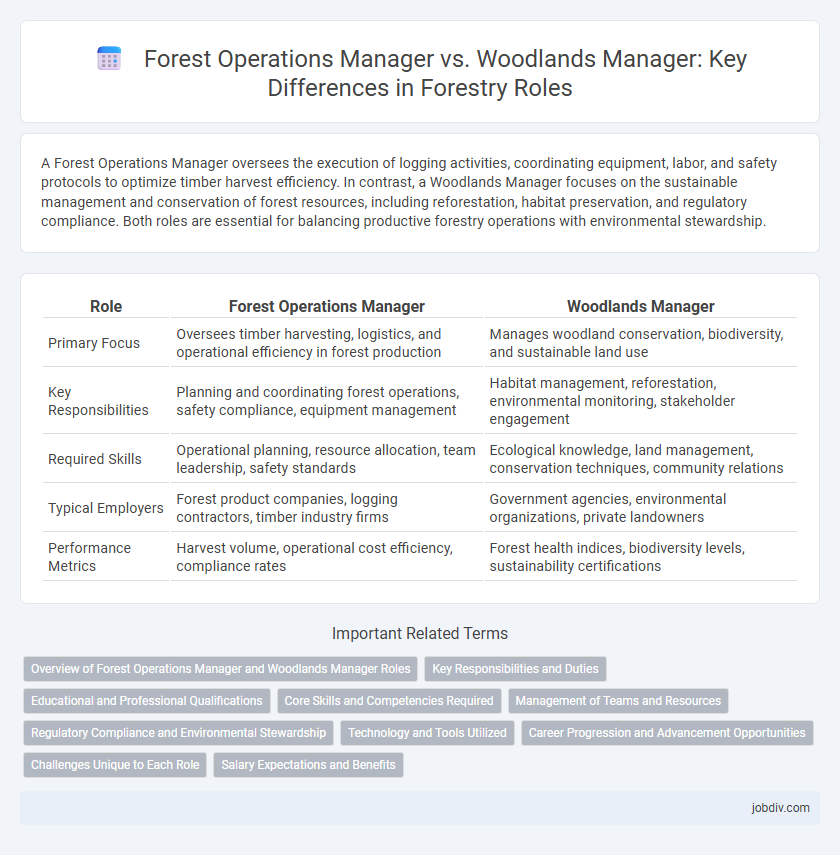A Forest Operations Manager oversees the execution of logging activities, coordinating equipment, labor, and safety protocols to optimize timber harvest efficiency. In contrast, a Woodlands Manager focuses on the sustainable management and conservation of forest resources, including reforestation, habitat preservation, and regulatory compliance. Both roles are essential for balancing productive forestry operations with environmental stewardship.
Table of Comparison
| Role | Forest Operations Manager | Woodlands Manager |
|---|---|---|
| Primary Focus | Oversees timber harvesting, logistics, and operational efficiency in forest production | Manages woodland conservation, biodiversity, and sustainable land use |
| Key Responsibilities | Planning and coordinating forest operations, safety compliance, equipment management | Habitat management, reforestation, environmental monitoring, stakeholder engagement |
| Required Skills | Operational planning, resource allocation, team leadership, safety standards | Ecological knowledge, land management, conservation techniques, community relations |
| Typical Employers | Forest product companies, logging contractors, timber industry firms | Government agencies, environmental organizations, private landowners |
| Performance Metrics | Harvest volume, operational cost efficiency, compliance rates | Forest health indices, biodiversity levels, sustainability certifications |
Overview of Forest Operations Manager and Woodlands Manager Roles
Forest Operations Managers coordinate timber harvesting, transportation, and site restoration, ensuring sustainable practices comply with environmental regulations. Woodlands Managers focus on the long-term health, conservation, and productivity of woodland areas, overseeing tree planting, habitat management, and biodiversity enhancement. Both roles require expertise in forestry planning, resource management, and regulatory compliance, but Forest Operations Managers emphasize operational logistics while Woodlands Managers prioritize ecological stewardship.
Key Responsibilities and Duties
A Forest Operations Manager oversees large-scale timber harvesting, ensuring compliance with environmental regulations, managing equipment and labor efficiency, and coordinating logistics to optimize production. In contrast, a Woodlands Manager focuses on sustainable forest management practices, including planning reforestation, monitoring ecosystem health, and maintaining biodiversity. Both roles require expertise in forest ecology, but the Forest Operations Manager emphasizes operational productivity, while the Woodlands Manager prioritizes conservation and long-term resource stewardship.
Educational and Professional Qualifications
Forest Operations Managers typically require a bachelor's degree in forestry, environmental science, or natural resource management, combined with certifications such as Certified Forester (CF) from the Society of American Foresters. Woodlands Managers often hold degrees in forestry or ecology and benefit from professional qualifications like the Registered Professional Forester (RPF) designation, emphasizing sustainable woodland stewardship. Both roles demand extensive field experience, with Forest Operations Managers focusing more on operational logistics and Woodlands Managers on ecological and conservation practices.
Core Skills and Competencies Required
A Forest Operations Manager requires expertise in project management, resource allocation, and environmental compliance to oversee large-scale timber harvesting and operational efficiency. In contrast, a Woodlands Manager focuses on silviculture knowledge, biodiversity conservation, and stakeholder engagement to sustainably manage woodland ecosystems and habitat restoration. Both roles demand strong leadership, knowledge of forestry regulations, and proficiency in GIS technology to optimize forest resource management.
Management of Teams and Resources
Forest Operations Managers specialize in overseeing large-scale forestry projects, coordinating multiple teams to efficiently manage harvesting, planting, and maintenance activities while optimizing resource allocation. Woodlands Managers focus on sustainable forest stewardship, leading smaller, localized teams to balance conservation efforts with timber production, ensuring long-term ecosystem health. Effective management of personnel and resources in both roles requires expertise in logistical planning, safety protocols, and environmental regulations.
Regulatory Compliance and Environmental Stewardship
Forest Operations Managers oversee timber harvesting activities ensuring strict adherence to forestry regulations, safety standards, and sustainable yield practices to optimize resource extraction. Woodlands Managers focus on long-term environmental stewardship by implementing conservation strategies, habitat protection, and reforestation efforts that maintain ecosystem health and biodiversity. Both roles require comprehensive knowledge of legal frameworks such as the Forest Practices Act and environmental policies to balance economic objectives with ecological sustainability.
Technology and Tools Utilized
Forest Operations Managers primarily utilize advanced remote sensing technologies, GPS mapping tools, and automated machinery to enhance harvesting efficiency and site management. Woodlands Managers focus on ecological monitoring software, drone surveillance for habitat assessment, and GIS applications to support sustainable woodland conservation and biodiversity. Both roles integrate data analytics platforms for decision-making but emphasize different technological tools aligned with operational versus ecological management goals.
Career Progression and Advancement Opportunities
Forest Operations Managers typically oversee large-scale timber harvesting projects and coordinate logistics, making them pivotal in optimizing resource extraction and ensuring sustainability. Woodlands Managers focus on long-term forest health, biodiversity, and conservation efforts, often advancing through roles in environmental consultancy or policy development. Career progression for Forest Operations Managers commonly leads to senior management positions in forestry companies, while Woodlands Managers may advance toward specialized ecological management or leadership in conservation organizations.
Challenges Unique to Each Role
Forest Operations Managers face challenges related to coordinating large-scale timber harvests, ensuring safety compliance, and optimizing machinery use in varying terrain conditions. Woodlands Managers encounter unique difficulties in balancing conservation efforts with sustainable forestry practices, managing biodiversity, and engaging stakeholders in long-term land stewardship. Both roles require adaptive strategies, but Operations Managers prioritize operational efficiency while Woodlands Managers focus on ecological health and community relations.
Salary Expectations and Benefits
Forest Operations Managers typically earn higher salaries, ranging from $60,000 to $90,000 annually, due to their responsibilities overseeing large-scale timber harvesting and logistics. Woodlands Managers generally earn between $45,000 and $70,000, reflecting their focus on sustainable woodland management and conservation practices. Benefits for both roles often include health insurance, retirement plans, and opportunities for professional development, with Forest Operations Managers sometimes receiving performance bonuses tied to operational efficiency.
Forest Operations Manager vs Woodlands Manager Infographic

 jobdiv.com
jobdiv.com